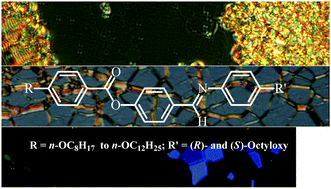Optically active, three-ring calamitic liquid crystals: the occurrence of frustrated, helical and polar fluid mesophases
Abstract
Herein, we report on the synthesis, characterization, liquid crystalline behavior and chirooptical properties of five (R)-4-{[(4-(octan-2-yloxy)phenyl)imino]methyl}phenyl 4-(n-alkoxy)benzoates and their enantiomers, namely, (S)-4-{[(4-(octan-2-yloxy)phenyl)imino]methyl}phenyl 4-(n-alkoxy)benzoates. These three-ring rod-like mesogens were prepared by acid catalyzed condensation of (R)-/(S)-4-(octan-2-yloxy)anilines with 4-formylphenyl 4-(n-alkoxy)benzoates. Thus, each pair of enantiomers comprises (R)-2-octyloxy and (S)-2-octyloxy chiral tails. In order to understand the structure–property correlations, the length of the paraffinic chain incorporated at the other end has been varied from n-octyloxy to n-dodecyloxy. A detailed study carried out by means of several complimentary techniques reveals the stabilization of liquid crystal phases that hold great promise in applied sciences especially in various device applications. In particular, the occurrence of mesophases such as the blue phase-I/II (BPI or BPII) and chiral nematic (N*) and chiral smectic C (SmC*) phases has been evidenced unequivocally with the help of polarizing microscopy, differential scanning calorimetry, X-ray diffraction and electrical switching. Besides, the occurrence of an unknown, metastable smectic (SmX) phase below the SmC* phase has been noted. This study shows that the length of the terminal tail seems to determine the thermal range of the SmC* phase. The enantiotropic SmC* phase exhibiting ferroelectric switching behavior occurs over 60 °C thermal range; notably, the spontaneous polarization (Ps) value crosses over 100 nC cm−2. The photophysical properties and chirooptical behavior of the mesogens have been studied with the aid of UV-vis absorption and circular dichroism (CD) spectroscopic methods, respectively; the latter technique has been especially used to ascertain the twist sense of the N* and SmC* phases formed by a pair of enantiomers. The reversal of the helix-sense (from right to left and vice versa) during the N*–SmC* phase transition has been observed for the first time.


 Please wait while we load your content...
Please wait while we load your content...